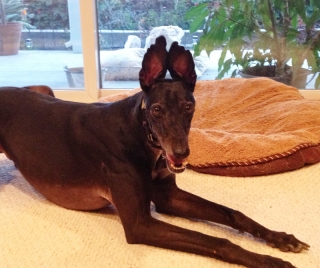Empathy for the Reactive Dog – Keepin’ it Real

Living with a reactive dog is a humbling experience on many levels. The understanding of the world that humans gain via language, experience and rational explanations for nearly everything are not part of the reactive dog's natural repertoire. However, we might be more similar at a basic level than we choose to admit. Taking time to shake off the clinical topography and protocols now and then and just reconnecting with how fear really feels can make us better trainers.
One of my dogs, Niki, came to us at 2 years old from the greyhound racing industry where he grew up and raced his entire life up to that point (26 races to be exact.) His body shows the physical scars and pieces missing, and his behavior shows the emotional ones. His dog reactivity was the most extreme case I think I’ve ever seen. I’m happy to say he’s in recovery, but we’re not there yet. I always tell my reactive dog clients that reactivity is not an “on/off” switch; it’s more like a dimmer.
We all understand that fear is necessary for survival; however fear isn’t fun while it’s happening and people are not that dissimilar to dogs at the core. This reminds me of a couple of human examples that might help us respect our dogs’ point of view and hopefully give us insight into the dog’s experience and how to patiently help them heal.
Example One: My husband and I were at an off-site airport parking structure recently and I was left to watch the bags while he parked the car several flights up. It was a dark, foggy, very early morning, and nobody was around. Suddenly, I felt vulnerable, a bit scared and definitely ill-at-ease as I waited for him to return. Dare I say, “hyper-vigilant”?! Rationally I knew that there were probably cameras around, the shuttle bus would be by soon, my husband would be back shortly and all would be well. That being said, I was acutely aware of my basic survival instinct, and how I hadn’t felt like that for a long time, “rational” or not. It made me think of Niki and other dogs like him who feel “on guard” in the here-and-now but without the benefit of explanations.
Example Two: Twenty years ago I was at a hair salon and had to go under a dryer to bake my color on. The stylist put the dryer lid down over my wet head and a giant wolf-like spider tumbled down onto my chest then attempted to scurry away amidst my shrieks and flailing arms. I have goose bumps now writing this (not a big spider fan). To this day, even though I go to a different salon, in a different city, and I’m 20 years older… I look quickly behind the hair dryer cap before sitting in the chair EVERY SINGLE TIME. Speaking of association and consequences, thank you very much….apparently it’s not just dogs who learn that way! Rationally I know it was a one-time thing not likely to happen again, but it made a big impact on how I perceive that specific situation to this day. If my stylist was a trainer who knew about classical conditioning or “Open bar/Closed bar” protocols, and she gave me some tasty cheese and chardonnay paired with the dryer cap it might take the edge off a little bit, but I might still be on the look out.
Humans and dogs alike, we all have imprints and issues whether we want to admit them or not. I’m quite sure I’m a resource guarder in certain contexts with separation anxiety to boot! Am I over-sharing?! In any case, I believe it’s important to feel and connect at that base level now and again to keep us humble, empathetic and patient as we work with dogs of all temperaments and particularly with reactive dogs. It never hurts to keep it real.




